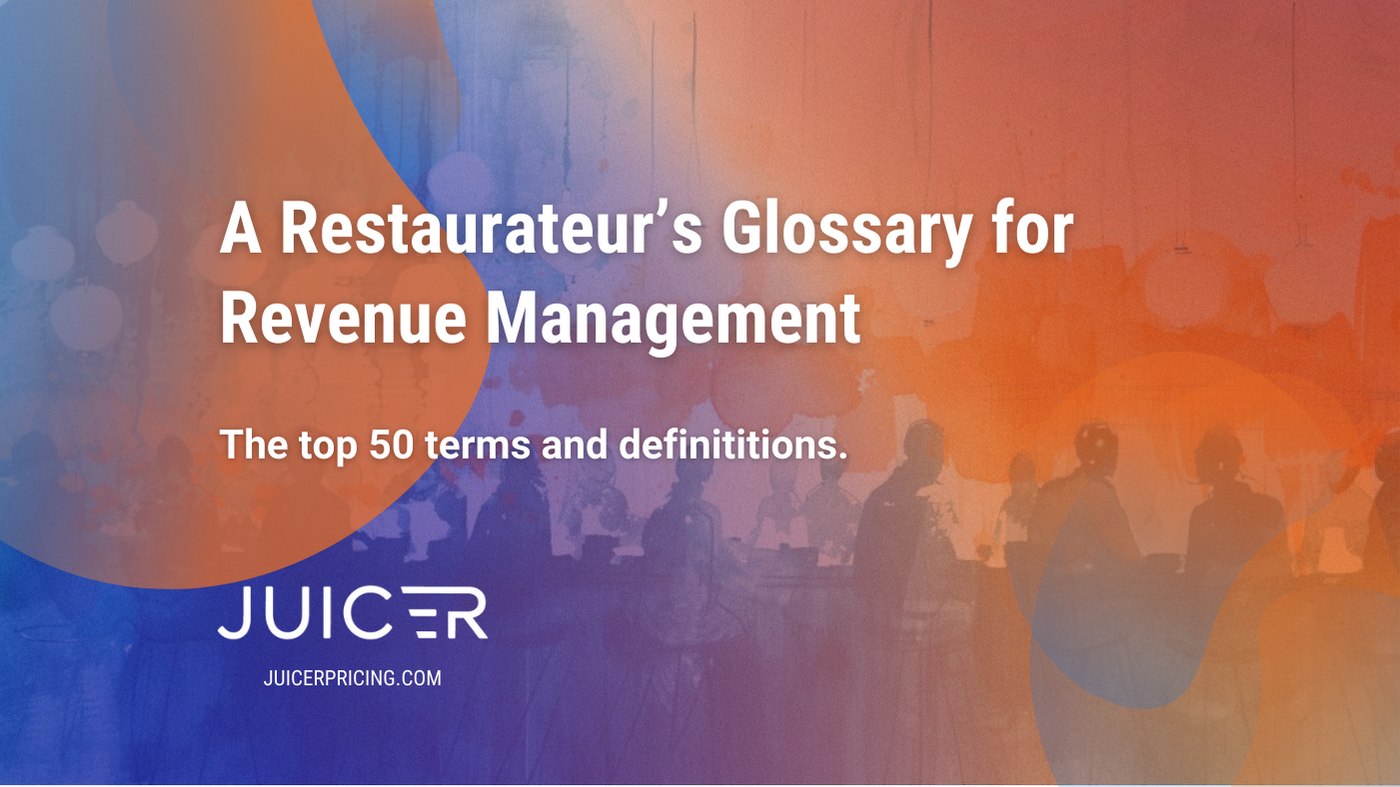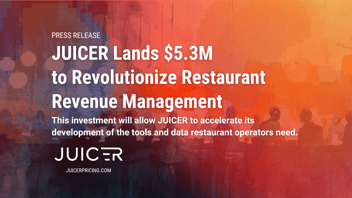Welcome to "A Restaurateur's Glossary for Revenue Management." As you explore the complexities of maximizing your restaurant's revenue, understanding the key terms and concepts is crucial. This 50-word glossary is designed to equip you with the knowledge needed to navigate the dynamic field of revenue management effectively. Whether you're fine-tuning existing strategies or exploring new approaches to pricing and profit optimization, these definitions will serve as a practical guide. Use this resource to enhance your decision-making process and drive your establishment's financial success.
Let's get started on enhancing your revenue management journey with clarity and confidence.Here are the terms in alphabetical order, with added detail for those most critical to menu optimization and dynamic pricing:
A
AI-Powered Pricing Solutions: Pricing systems using artificial intelligence to analyze data and automate pricing decisions, enabling restaurants to respond to market changes swiftly and efficiently.
Analytics-driven Price Setting: Utilizing data analytics to inform and refine pricing decisions, ensuring that pricing strategies are based on solid data insights rather than guesswork.
Automated Pricing Systems: Systems that automatically set and adjust prices using algorithms and data analysis, reducing the manual workload and increasing pricing efficiency.
B
Behavioral Pricing in Restaurants: A strategy that leverages understanding of human behavior and psychology to set prices, aiming to positively influence customer perceptions and increase sales.
C
Competitive Pricing Analysis: The study of competitors’ prices to inform a restaurant's pricing strategy, ensuring that pricing is competitive yet profitable.
Cost-driven Pricing Decisions: Pricing decisions influenced primarily by the cost of goods sold and operational expenses, ensuring prices cover costs while remaining attractive to customers.
Customer Demand Forecasting: Predicting future customer demand using historical data and trends to make informed decisions about menu pricing and availability.
Customer Segmentation Pricing: Setting different prices for different customer groups based on characteristics like behavior or demographics to maximize revenue from each segment.
D
Data-driven Price Adjustment: Using data analysis to inform decisions about when and how to adjust prices, ensuring that pricing decisions are backed by real-time data.
Demand-based Menu Pricing: Setting menu prices based on customer demand levels at different times or days, allowing for optimization of revenue through strategic pricing.
Digital Menu Board Pricing: Utilizing digital displays for menus, which allows for easy and dynamic changes to pricing, adapting to demand or promotional strategies quickly.
Digital Pricing Optimization: The use of digital tools and platforms to optimize pricing strategies, ensuring that digital channels are utilized effectively for price management.
Dynamic Discounting Strategies: Techniques for offering variable discounts based on current market conditions or customer behavior to drive sales and manage demand.
Dynamic Pricing in Fast Casual: Applying flexible pricing strategies in the fast-casual dining sector based on real-time demand and other factors, optimizing revenue in a competitive segment.
Dynamic Pricing Strategies: Adjusting prices in real-time based on demand, competition, and other market factors such as weather and events, maximizing revenue through responsive pricing.
Dynamic Special Offers: Changing special offers and promotions dynamically based on market conditions or strategic goals to attract customers and increase sales volume.
F
Food Cost Analysis: Calculating the cost of ingredients and preparation for menu items to inform pricing decisions, ensuring that each item is priced for profitability.
Food Industry Price Trends: Understanding and responding to broader pricing trends in the food and restaurant industry to ensure pricing strategies are aligned with market expectations.
G
Geo-based Dynamic Pricing: Adjusting prices based on the geographical location of the restaurant or customer, taking into account local demand and competition.
H
High-demand Period Pricing: Setting higher prices during periods of peak demand, such as popular dining hours, to maximize revenue when customer willingness to pay is higher.
I
Intelligent Pricing Algorithms: Software algorithms that automatically set and adjust prices based on a variety of factors, optimizing pricing decisions with minimal human intervention.
L
Local Market Pricing Analysis: Studying the pricing strategies and conditions of the local market to inform a restaurant's pricing decisions, ensuring competitiveness and market alignment.
M
Menu Engineering for Profit: Analyzing and strategically designing menus for profitability based on the cost and popularity of items, optimizing the menu layout and selection for maximum profit.
Menu Item Profit Margins: The difference between the cost of producing a menu item and its selling price, crucial for understanding the profitability of each menu item.
Menu Price Optimization: Setting menu prices to maximize profit while maintaining customer satisfaction, balancing the need for profitability with the value offered to customers.
Menu Profitability Analytics: Analyzing which menu items are most profitable based on cost and sales data, guiding decisions on menu design and item promotion.
Multi-channel Pricing Strategy: Setting prices across different sales channels (e.g., in-house, online, third-party delivery, 3PO, etc) in a coordinated manner to optimize revenue across all platforms.
P
Peak Hour Pricing: Charging higher prices during times of high demand to maximize revenue during peak business periods, leveraging customer willingness to pay.
Predictive Pricing Models: Pricing models that use data to predict future market conditions and set prices accordingly, enabling proactive adjustments to pricing strategies.
Pricing Psychology in Restaurants: Applying principles of psychology to set prices in a way that positively influences customer perception, encouraging purchase behavior through strategic pricing.
Pricing Strategy Consulting: Professional services focused on developing effective pricing strategies, providing expertise to optimize pricing for revenue growth.
Profit Maximization in Hospitality: Increasing a hospitality business's profits through pricing, cost control, and service enhancement, ensuring overall financial health and sustainability.
Profitable Menu Design: Creating a menu layout and item selection focused on maximizing profits, strategically selecting and pricing items for optimal revenue generation.
R
Real-time Pricing Analysis: Continuously analyzing pricing data to make immediate adjustments as market conditions change, ensuring pricing remains competitive and profitable.
Revenue-focused Menu Planning: Designing a menu with the primary goal of maximizing revenue, strategically selecting items and pricing to drive profitability.
Revenue Management for Restaurants: Optimizing income through pricing, inventory control, and demand forecasting, ensuring a strategic approach to revenue generation.
Revenue Management Training: Educational programs that teach restaurant managers and staff about effective revenue management strategies, building expertise within the team.
Revenue Optimization Software: Tools designed to help businesses analyze data and make informed pricing decisions, streamlining the process of revenue management.
Restaurant Rate Management: Managing and optimizing the rates charged for dining based on demand, competition, and cost, ensuring pricing strategies are aligned with business goals.
Restaurant Yield Management: Understanding, anticipating, and influencing diner behavior to maximize revenue from a fixed, perishable inventory, such as restaurant seats.
S
Sales Data Analysis for Pricing: Using past sales data to inform and optimize pricing strategies, ensuring pricing decisions are based on actual sales performance.
Seasonal Menu Pricing: Adjusting menu prices in response to changes in demand during different seasons, aligning pricing with customer demand patterns.
Strategic Revenue Growth: Deliberate planning and implementation of tactics aimed at increasing a business's revenue, focusing on long-term financial success.
Supply Chain Cost Management: Controlling and optimizing costs associated with the supply chain to impact overall pricing and profitability, ensuring cost efficiency.
T
Third-party Delivery Pricing: Setting and adjusting prices for menu items sold through third-party delivery services, taking into account the fees and competitive landscape.
Time-based Menu Pricing: Adjusting prices at different times of the day or week to reflect demand variations, optimizing revenue through strategic pricing adjustments.
U
Upselling and Cross-selling Prices: Setting prices to encourage customers to purchase higher-priced items or additional products, increasing average transaction value.
V
Value-based Pricing Strategy: Pricing based on the perceived value of the menu items to the customer, ensuring prices reflect the value offered rather than just the cost.




